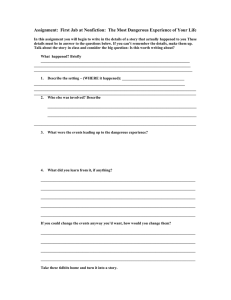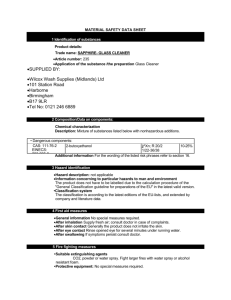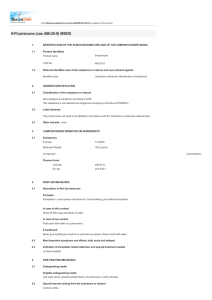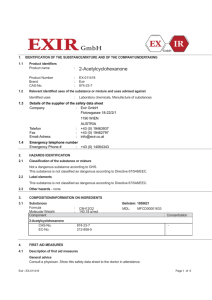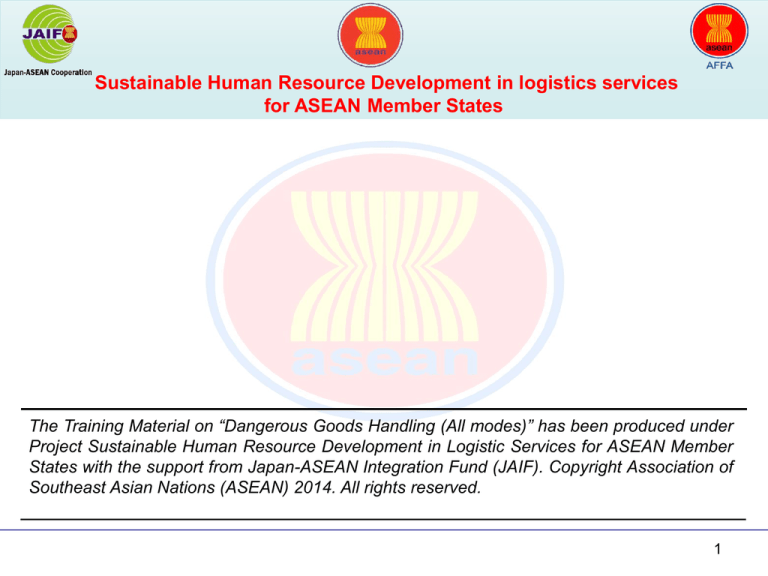
Sustainable Human Resource Development in logistics services
for ASEAN Member States
The Training Material on “Dangerous Goods Handling (All modes)” has been produced under
Project Sustainable Human Resource Development in Logistic Services for ASEAN Member
States with the support from Japan-ASEAN Integration Fund (JAIF). Copyright Association of
Southeast Asian Nations (ASEAN) 2014. All rights reserved.
1
Sustainable Human Resource Development in logistics services
for ASEAN Member States
International Maritime Dangerous Goods Code
(IMDG Code)
Mr. Chalermsak Karnchanawarin
Dangerous Goods Handling
Chapter 4-1: IMDG Code
2
Sustainable Human Resource Development in logistics services
for ASEAN Member States
IMDG Code
Objectives:
This chapter will cover the basic understanding on the
applicable transport regulation by Sea (International
Maritime Dangerous Goods Code : IMDG Code)
The History, Principles and Layout of IMDG Code will be
explained.
It covers Basic Hazard Classification and Hazard
Communication under IMDG Code.
The core element of the IMDG Code will be explained on how
to read the information in Dangerous Goods List (DGL)
Dangerous Goods Handling
ChChapter 4-1: IMDG Code
3
Sustainable Human Resource Development in logistics services
for ASEAN Member States
IMDG Code
Objectives:
The Training Requirements under IMDG Code will be
explained.
The example of how to use IMDG Code will also be
demonstrated.
Dangerous Goods Handling
ChChapter 4-1: IMDG Code
4
Sustainable Human Resource Development in logistics services
for ASEAN Member States
IMDG Code
Presentation Outline
International Legal Framework
IMDG Code
Principles and Layout of IMDG Code
IMDG Code Classification System
The 9 Classes of Dangerous Goods
UN Number & Proper Shipping Names
Hazard Labels
Understanding the Dangerous Goods List (DGL)
Training Requirements
Using IMDG Code
Dangerous Goods Handling
Chapter 4-1: IMDG Code
5
Sustainable Human Resource Development in logistics services
for ASEAN Member States
The International Legal Framework
The International Maritime Organization (IMO) is a
United Nations specialized agency which has developed
international legislation dealing with two key issues for the
maritime industry:
The safety of life at sea
Prevention of pollution from ships
The IMO has developed two international conventions
to address these two issues
The SOLAS Convention (covering safety of life at sea)
The MARPOL Convention (covering pollution
prevention)
Dangerous Goods Handling
Chapter 4-1: IMDG Code
6
Sustainable Human Resource Development in logistics services
for ASEAN Member States
The International Legal Framework
To supplement the principles laid down in the SOLAS and MARPOL
Conventions, the IMO developed the International Maritime
Dangerous Goods (IMDG) Code
The IMDG Code contains detailed technical specifications to enable
dangerous goods to be transported safely by sea
The IMDG Code became mandatory in international law on 1st
January 2004
The objective of IMDG Code is to:-
Enhance the safe transport of dangerous goods
Protect the marine environment
Facilitate the free unrestricted movement of dangerous goods
Dangerous Goods Handling
Chapter 4-1: IMDG Code
7
Sustainable Human Resource Development in logistics services
for ASEAN Member States
IMDG Code
International Maritime
Dangerous Goods Code
IMDG Code
“Amendment 36-12”
Issued year: 2013
Dangerous Goods Handling
Chapter 4-1: IMDG Code
8
Sustainable Human Resource Development in logistics services
for ASEAN Member States
Principles of IMDG Code
groups dangerous goods together based on the hazards they
present in transport (classification);
contains the dangerous goods in packagings/tanks which are of
appropriate strength and which will prevent the goods escaping
(proper packaging);
uses hazard warning labels and other identifying marks to identify
dangerous goods in transport (communication);
requires standard documentation to be provided when dangerous
goods are being transported (documentation);
Dangerous Goods Handling
Chapter 4-1: IMDG Code
9
Sustainable Human Resource Development in logistics services
for ASEAN Member States
Principles of IMDG Code
lays down principles for ensuring that those dangerous goods which
will react dangerously together are kept apart (segregation);
lays down principles for where to place dangerous goods on board
ship to ensure safe transport (stowage);
provides emergency response advice for dangerous goods involved
in a fire or spillage on board ship (emergency response).
Dangerous Goods Handling
Chapter 4-1: IMDG Code
10
Sustainable Human Resource Development in logistics services
for ASEAN Member States
Principles of IMDG Code
Updating IMDG Code
The IMDG Code is an international regulation which is continuously
evolving and is updated every two years to take account of:
new dangerous goods which have to be included;
new technology and new methods of working with/handling
dangerous goods
safety concerns which arise as a result of human experience.
each version of the Code is given an Amendment Number to signify
how many times it has been updated. This number appears at the
bottom of each page together with the year of amendment.
current Amendment 36-12 must be used.
Dangerous Goods Handling
Chapter 4-1: IMDG Code
11
Sustainable Human Resource Development in logistics services
for ASEAN Member States
Principles of IMDG Code
Each Amendment is valid for up to three years.
There are alternating years for implementation.
In January of the yellow years, a new Amendment is published and can be used
immediately, subject to the timing of National Competent Authority adoption.
During the yellow years, the preceding Amendment can also be used, so it is a transition
year.
In the green years, only the current Amendment may be used.
Dangerous Goods Handling
Chapter 4-1: IMDG Code
12
Sustainable Human Resource Development in logistics services
for ASEAN Member States
Layout of IMDG Code
The code is composed of 7 parts
The code is presented in two
books, volume 1 and volume 2
It is necessary to use both books
to obtain the required information
when shipping dangerous goods
by sea.
The code also contains a
supplement
Dangerous Goods Handling
Chapter 4-1: IMDG Code
13
Sustainable Human Resource Development in logistics services
for ASEAN Member States
Layout of IMDG Code
Volume 1 (Part 1-2, 4-7 of the Code) contains the following:
Part 1: General provisions, definitions and training
Part 2: Classification
Part 4: Packing and Tank Provision
Part 5: Consignment Procedures
Part 6: Construction and Testing of Packaging, Intermediate Bulk
Containers (IBCs), Large Packaging, Portable Tanks, MultipleElement Gas Containers (MEGC’S) and Road Tank Vehicles
Part 7: Requirements Concerning Transport Operations
Dangerous Goods Handling
Chapter 4-1: IMDG Code
14
Sustainable Human Resource Development in logistics services
for ASEAN Member States
Layout of IMDG Code
Volume 2 (Part 3 and the Appendices) contains the following:
Part 3: Dangerous Goods List (DGL) and Limited Quantities
Exceptions
The DGL is the central core of the IMDG Code and presents
information on the transport requirements for all dangerous goods
in a coded form [Insert graphic].
Appendix A: List of Generic and N.O.S. Proper Shipping Names
Appendix B: Glossary of terms
Alphabetical Index
Dangerous Goods Handling
Chapter 4-1: IMDG Code
15
Sustainable Human Resource Development in logistics services
for ASEAN Member States
Layout of IMDG Code
The Supplement contains the following texts related to the
Code:
Emergency Response Procedures for Ships Carrying Dangerous
Goods ;
Medical First Aid Guide (MFAG);
Reporting Procedures;
IMO/ILO/ECE Guidelines for Packing Cargo Transport Units;
Safe Use of Pesticides in Ships
International Code for the Carriage of Packaged Irradiate Nuclear
Fuel, Plutonium and High-Level Radioactive Wastes on board
ships.
Dangerous Goods Handling
Chapter 4-1: IMDG Code
16
Sustainable Human Resource Development in logistics services
for ASEAN Member States
IMDG Code Classification System
The purpose of the IMDG Code’s classification system is:
to distinguish between goods which are considered to be dangerous for
transport and those which are not
to identify the dangers which are presented by dangerous goods in transport
to ensure that the correct measures are taken to enable these goods to be
transported safely without risk to persons or property (both within the port and
on the ship).
Dangerous goods are classified into one of 9 classes which all have differing
properties. The way in which different classes of dangerous goods are handled in
transport will depend upon these properties and the hazards presented and effects
the type of packing that can be used
what classes of dangerous goods can be transported together in freight
containers,
where the goods can be stored within the port and on the ship
Dangerous Goods Handling
Chapter 4-1: IMDG Code
17
Sustainable Human Resource Development in logistics services
for ASEAN Member States
The 9 Classes of Dangerous Goods
Class 1
Class 2
Class 3
Class 4
Class 5
Class 6
Class 7
Class 8
Class 9
Explosives
Gases
Flammable liquids
Flammable solids
Oxidizing substances and organic peroxides
Toxic and infectious substances
Radioactive material
Corrosive substances
Miscellaneous dangerous substances and articles
These 9 hazard classes have been established internationally by a United
Nations (UN) committee to ensure that all modes of transport (road, rail, air
and sea) classify dangerous goods in the same way.
Dangerous Goods Handling
Chapter 4-1: IMDG Code
18
Sustainable Human Resource Development in logistics services
for ASEAN Member States
UN Number & Proper Shipping Names
Within each of the 9 hazard classes dangerous goods are uniquely identified
by two pieces of information:
A four-digit number known as the UN Number which is preceded by
the letters UN.
The corresponding Proper Shipping Name (PSN).
For example, kerosene is identified in the IMDG Code by its UN Number UN
1223 and the PSN Kerosene.
Together the UN Number and PSN uniquely identify dangerous goods to:
enable rapid and precise identification during transport to ensure the
correct handling, stowage, segregation etc, and
in the event of an emergency, ensure that the correct procedures are
followed.
Dangerous Goods Handling
Chapter 4-1: IMDG Code
19
Sustainable Human Resource Development in logistics services
for ASEAN Member States
Hazard Labels
Each of the hazard classes are also identified by labels:
Dangerous Goods Handling
Chapter 4-1: IMDG Code
20
Sustainable Human Resource Development in logistics services
for ASEAN Member States
Understanding the Dangerous Goods List (DGL)
The DGL is presented across 2 pages of the IMDG Code and is
divided into 18 columns for each individual dangerous good
listed.
Much of the information contained in the DGL is coded to make it
easier to present in a table.
The DGL is arranged in UN Number order; column 1 and column
18 contains the UN Number.
To look up an entry, you just need the UN Number.
However, dangerous goods can also be searched using the PSN.
Therefore, if you do not have the UN Number but have the PSN,
you can find its associated UN Number by looking at the
alphabetical index at the back of Volume 2.
Dangerous Goods Handling
Chapter 4-1: IMDG Code
21
Sustainable Human Resource Development in logistics services
for ASEAN Member States
Understanding the Dangerous Goods List (DGL)
Column 1 – UN Number
Contains the United Nations Number assigned by the United Nations
Committee of Experts on the Transport of Dangerous Goods (UN List).
Column 2 – Proper Shipping Name (PSN)
Contains the Proper Shipping Names in upper case characters which may
be followed by additional descriptive text in lower-case characters.
Column 3 – Class or Division
Contains the class and, in the case of class 1, the division and compatibility
group.
Column 4 – Subsidiary Risk(s)
Contains the class number(s) of any subsidiary risk(s). This column also
identifies if dangerous goods are marine pollutants by showing the letter ‘P’:
Dangerous Goods Handling
Chapter 4-1: IMDG Code
22
Sustainable Human Resource Development in logistics services
for ASEAN Member States
Understanding the Dangerous Goods List (DGL)
Column 5 – Packing Group
Contains the packing group number (i.e. I, II or III) where assigned to the
substance or article.
Column 6 – Special Provisions
Contains a number referring to any special provision(s) indicated in chapter
3.3.
Column 7a – Limited Quantities
Provides the maximum quantity per inner packaging.
Column 7b – Excepted Quantities
Provides a code which can be referenced to determine the maximum quantity
per inner and outer packaging.
Dangerous Goods Handling
Chapter 4-1: IMDG Code
23
Sustainable Human Resource Development in logistics services
for ASEAN Member States
Understanding the Dangerous Goods List (DGL)
Column 8 – Packing Instructions
Contains packing instructions for the transport of substances and articles.
Column 9 – Special Packing Provisions
Contains special packing provisions.
Column 10 – IBC Packing Instructions
Contains IBC instructions which indicate the type of IBC that can be used for
the transport.
Column 11 – IBC Special Provisions
Refers to special packing provisions applicable to the use of packing
instructions bearing the code ‘IBC’ in 4.1.4.2.
Dangerous Goods Handling
Chapter 4-1: IMDG Code
24
Sustainable Human Resource Development in logistics services
for ASEAN Member States
Understanding the Dangerous Goods List (DGL)
Column 12 – IMO Tank Instructions
This column is no longer used but used to apply to IMO portable tanks and
road tank vehicles.
Column 13 – UN Tank and Bulk Container Instructions
Contains T codes (see 4.2.5.2.6) applicable to the transport of dangerous
goods in portable tanks and road tank vehicles.
Column 14 – Tank Special Provisions
Contains TP notes (see 4.2.5.3) applicable to the transport of dangerous goods
in portable tanks and road road tank vehicles.
Dangerous Goods Handling
Chapter 4-1: IMDG Code
25
Sustainable Human Resource Development in logistics services
for ASEAN Member States
Understanding the Dangerous Goods List (DGL)
Column 15 – EmS
Refers to the relevant emergency schedules for FIRE and SPILLAGE in ‘The
EmS Guide – Emergency Response Procedures for Ships Carrying Dangerous
Goods’.
Column 16 – Stowage and Segregation
Contains the stowage and segregation provisions as prescribed in part 7.
Column 17 – Properties and Observations
Contains properties and observations on the dangerous goods listed.
Column 18 – UN Number
Contains the United Nations Number for ease of reference across both pages
of the printed book.
Dangerous Goods Handling
Chapter 4-1: IMDG Code
26
Sustainable Human Resource Development in logistics services
for ASEAN Member States
Training Requirements
In the 2002 edition of the IMDG Code, training was introduced for the
first time.
The IMO Member Governments recognized that
the safe transport of dangerous goods by sea is
dependent upon the appreciation, by all persons
involved, of the risks involved and on a detailed
understanding of the IMDG Code requirements.
The training requirements became mandatory with Amendment 34-08.
Dangerous Goods Handling
Chapter 4-1: IMDG Code
27
Sustainable Human Resource Development in logistics services
for ASEAN Member States
Training Requirements
These training requirements highlight the need for all shore-based personnel
involved in the shipment of dangerous goods to receive training commensurate
with their responsibilities. The IMDG Code defines shore-based personnel as
those who:
Classify dangerous goods and identify PSNs
Pack dangerous goods
Mark, label or placard dangerous goods
Load/unload CTUS
Prepare transport documents for dangerous goods
Offer dangerous goods for transport
Accept dangerous goods for transport
Handle dangerous goods in transport
Dangerous Goods Handling
Chapter 4-1: IMDG Code
28
Sustainable Human Resource Development in logistics services
for ASEAN Member States
Training Requirements
These training requirements highlight the need for all shore-based personnel
involved in the shipment of dangerous goods to receive training commensurate
with their responsibilities. The IMDG Code defines shore-based personnel as
those who:
Prepare dangerous goods loading/stowage plans
Load/unload dangerous goods into/ from ships
Carry dangerous goods in transport
Enforce, survey or inspect for compliance with applicable rules and
regulations
Dangerous Goods Handling
Chapter 4-1: IMDG Code
29
Sustainable Human Resource Development in logistics services
for ASEAN Member States
Using IMDG Code – Acetone / UN 1090
Dangerous Goods Handling
Chapter 4-1: IMDG Code
30
Sustainable Human Resource Development in logistics services
for ASEAN Member States
Using IMDG Code – Packing Instructions
Dangerous Goods Handling
Chapter 4-1: IMDG Code
31
Sustainable Human Resource Development in logistics services
for ASEAN Member States
Using IMDG Code – IBC & Tanks Instructions
Dangerous Goods Handling
Chapter 4-1: IMDG Code
32
Sustainable Human Resource Development in logistics services
for ASEAN Member States
Using IMDG Code – Tanks Provisions
Dangerous Goods Handling
Chapter 4-1: IMDG Code
33
Sustainable Human Resource Development in logistics services
for ASEAN Member States
Using IMDG Code – Fire Schedule
Dangerous Goods Handling
Chapter 4-1: IMDG Code
34
Sustainable Human Resource Development in logistics services
for ASEAN Member States
Using IMDG Code – Spillage Schedule
Dangerous Goods Handling
Chapter 4-1: IMDG Code
35
Sustainable Human Resource Development in logistics services
for ASEAN Member States
Using IMDG Code – Stowage & Segregation
Dangerous Goods Handling
Chapter 4-1: IMDG Code
36
Sustainable Human Resource Development in logistics services
for ASEAN Member States
Using IMDG Code – Load Validation
Dangerous Goods Handling
Chapter 4-1: IMDG Code
37
Sustainable Human Resource Development in logistics services
for ASEAN Member States
Using IMDG Code – Load Validation
Dangerous Goods Handling
Chapter 4-1: IMDG Code
38
Sustainable Human Resource Development in logistics services
for ASEAN Member States
Using IMDG Code – Load Validation
Dangerous Goods Handling
Chapter 4-1: IMDG Code
39
Sustainable Human Resource Development in logistics services
for ASEAN Member States
Using IMDG Code – Load Validation
Dangerous Goods Handling
Chapter 4-1: IMDG Code
40
Sustainable Human Resource Development in logistics services
for ASEAN Member States
International Maritime Dangerous Goods Code
(IMDG Code)
Mr. Chalermsak Karnchanawarin
Dangerous Goods Handling
Chapter 4-1: IMDG Code
41

